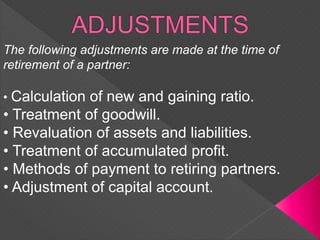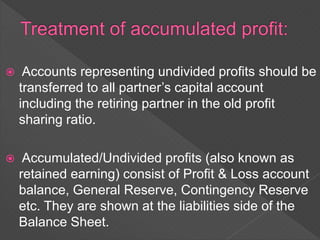Retirement of A Partner
- 2. The following adjustments are made at the time of retirement of a partner: âĒ Calculation of new and gaining ratio. âĒ Treatment of goodwill. âĒ Revaluation of assets and liabilities. âĒ Treatment of accumulated profit. âĒ Methods of payment to retiring partners. âĒ Adjustment of capital account.
- 3. ï New Profit Sharing Ratio Ratio of remaining partner is known as New profit sharing ratio, in which they share the future profits. New Share = Old Share + Acquired Share ï Gaining Ratio The ratio in which the continuing partners have acquired the share from the retiring partner is called the gaining ratio. Gaining Ratio = New Share âOld Share
- 4. K ,M and S are three partners sharing profit and losses in the ratio of 4:3:2 .K retires .M and S will share future profits and losses in the ratio of 5:3 .Determine the gaining ratio.
- 5. The retiring or deceased partner is entitled to his share of goodwill at the time of retirement because the goodwill has been earned by the firm with the efforts of all the existing partners. There are four steps in treatment of goodwill : ïž Step-1: Calculation of goodwill of the entire firm as per partners agreement including retiring partner. ïž Step-2: Ascertainment of retiring partnerâs share of goodwill. ïž Step-3: Calculation of gaining ratio. ïž Step-4: Accounting treatment
- 6. The term revaluation simply means âto determine the value of assets and liabilities againâ. In the preparation of revaluation account there are only two possibilities. It will be either profit or loss: ïķ Profit indicates excess of credit side over the debit side. {DEBIT SIDE} ïķ Loss indicates excess of debit side over the credit side. {CREDIT SIDE}
- 7. ï Accounts representing undivided profits should be transferred to all partnerâs capital account including the retiring partner in the old profit sharing ratio. ï Accumulated/Undivided profits (also known as retained earning) consist of Profit & Loss account balance, General Reserve, Contingency Reserve etc. They are shown at the liabilities side of the Balance Sheet.
- 8. ï The procedure of determining the amount payable to retiring partner is to prepare his capital account on the date of retirement. The retiring partner is entitled to get his share out of the following items: ï§ Share of Goodwill. ï§ Share of Accumulated Profit. ï§ Share of Profit on Revaluation. ï§ Interest on Capital. ï§ Share of Profit from the Closing of the Last Final Account to the Date of Retirement.
- 9. ï At the time of retirement of a partner, continuing partners may agree to fix their capital at a certain amount to make it in their profit sharing ratio. If such an agreement takes place then there will be an accounting impact which is as follows: I. The specified capital amount is distributed among continuing partners in their new profit sharing ratio. II. The closing balance of the capital should be restricted to the amount determined in step I. III. Any surplus over the adjusted capital is either returned to the partner in case or transferred to his/her current account.
- 10. The following problems arises at the time of retirement: ïą To revalue the assets & liabilities of the firm. ïą To fix-up the value of goodwill of the firm. ïą To make payment of the dues of retiring partner. ïą To determine the new profit sharing ratio. ïą To determine the new capital of the firm. ïą To distribute general reserve or profit and loss balance among all partners. ïą To ascertain the profit or loss up to the date of retirement.
- 12. K ,M and S are three partners sharing profit and losses in the ratio of 4:3:1 .K retires .M and S will share future profits and losses in the ratio of 5:3.Firmâs goodwill valued at Rs 80,000 .You are required to make adjusting entries for goodwill without opening goodwill account .
- 13. X, Y and Z are partners in a firm sharing profits and losses in the ratio of 3:2:1. Z retires from the firm on 1st April, 2014. On the date of Zâs retirement, following balances appeared in the books of the firm: General Reserves Rs 90,000; Profit and Loss Account (Dr.) Rs 15,000. Workmen Compensation Reserves Rs 12,000 which was no more required. Pass Journal Entries for the adjustment of these items on Zâs retirements.
- 15. PARTICULARS AMOUNT [Dr.] PARTICULARS AMOUNT [Cr.] To Assets (Decrease) By Assets (Increase) To Liabilities (Increase) By Liabilities (Decrease) To Unrecorded Liabilities By Unrecorded Assets To Old Partners Capital A/câs (Profit) To Old Partners Capital A/câs (Loss)
- 16. Balance Sheet of A,B and C sharing profits and losses in the ratio 5:3:2 as on 31st March,2016 was: B retires from the firm on 1st April,2016. A and C decided to share future profits and losses in the ratio of 3:1 respectively. Following adjustments are agreed: Liabilities Amount Assets Amount Sundry Creditors 15,000 Cash at Bank 27,000 Capital A/câs 1,05,000 Sundry Debtors 16000 15,200 A 46,000 (-) Provision (800) B 34,000 Stock 12,800 C 25,000 Plant and Machinery 35,000 Land and Building 30,000 1,20,000 1,20,000
- 17. 1) That an amount of Rs 1,100 included in debtors be written off as it is no longer receivable. 2) That a Provision for Doubtful Debts be maintained at the existing rate. 3) That stock be written down by Rs 1,055. 4) That Land and Building be written up by Rs11, 000. 5) That Plant and Machinery be reduced to Rs 34,000. 6) That an amount of Rs 700 included in Sundry Creditors be written back as no longer payable. 7) That a Provision of Rs 600 be made for an Outstanding Repair Bill. 8) An old computer previously written of was sold for RS 2000 as scrap. 9) Firm had to pay Rs 5,000 to an employee injured in an accident. Prepare Revaluation Account.
- 18. Particulars A B C Particulars A B C To Bal b/d By Bal b/d To Revaluation By Revaluation To Drawings By Salary To Int. on Drawings By Int. on Capital To Retiring Partnerâs Loan A/c By Undistributed Reserves To Bal c/d By Bal c/d Total Total
- 19. Liabilities Amount Assets Amount Sundry Creditors Cash at Bank Capital A/câs Sundry Debtors Reserves Goodwill Loan Stock Bills Payable Plant and Machinery Land and Building Patents Total Total
- 20. Manoj, Naveen and Deepak were partners sharing profits in the ratio of 3:2:1. On 1st April, 2016 Naveen retired. On that date Balance Sheet was: Liabilities Amount Assets Amount Sundry Creditors 10,000 Cash 500 Capital A/câs 31,000 Sundry Debtors 9,500 Manoj 12,000 Patents 3,000 Naveen 10,000 Stock 11,000 Deepak 9,000 Plant 30,000 General Reserve 6,000 Expenses Outstanding 2,000 Bills Payable 5,000 Total 54,000 Total 54,000
- 21. The terms were: a) Goodwill of the firm be valued at Rs 12,000 and Naveenâs share of goodwill be adjusted in the accounts of Manoj and Deepak who share the profits and losses in the ratio of 3:2. b) Expenses Outstanding are to be brought down to Rs 1,500; Plant is to be valued at 10% less and Patents at Rs 4,000. c) Total Capital of the new firm will be fixed at Rs 25,000 to be contributed by partners in profit sharing ratio. Prepare ledger accounts to record the above transactions and the balance sheet after Naveenâs retirement.














![PARTICULARS AMOUNT
[Dr.]
PARTICULARS AMOUNT
[Cr.]
To Assets (Decrease) By Assets (Increase)
To Liabilities
(Increase)
By Liabilities
(Decrease)
To Unrecorded
Liabilities
By Unrecorded
Assets
To Old Partners
Capital A/câs (Profit)
To Old Partners
Capital A/câs (Loss)](https://image.slidesharecdn.com/presentation11-180131124959/85/Retirement-of-A-Partner-15-320.jpg)





